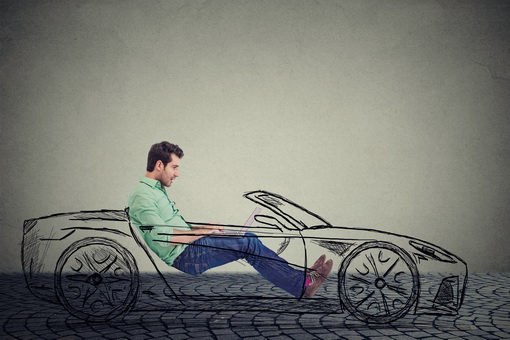Artical by Suwan Juntiwasarakij, Ph.D., Senior Editor
The vehicles have grown more powerful and luxurious. The network of roads, highways, and interstates has grown more elaborate and extensive, and more congested. Technological changes are underway that could finally reshape that system in fundamental ways. It is difficult enough to predict incremental changes in existing technologies and markets. Today, three technological shifts — autonomous (self-driving) vehicle, vehicle electrification, and distributed energy — that could change the transportation system are unfolding in parallel. This article shines the light on the autonomous vehicle facet.
STEPS TOWARD AUTONOMY
Google, Tesla, and Uber—companies that didn’t even exist when Toyota introduced the Prius, in 1997—have become major players in the auto industry. Both Google and Tesla aim to introduce fully autonomous cars—that is, cars that drive themselves—within the next several years, and Uber recently founded an R&D center in Pittsburgh with an eye toward ushering in our driverless future. Self-driving cars are expected to be much safer than human-driven ones. But even if the first robot cars hit the roads in the next few years, most of us probably won’t give up driving entirely for at least another 15 or 20 years.

SOURCE: STATISTA
Automotive companies have been adding semiautonomous features to cars since the 1990s—things like adaptive cruise control, which uses sensors to adjust a car’s speed based on the traffic in front of it, and automated parallel parking. Some cars automatically stop—or at least slow down—if a driver doesn’t step on the brake in time to avoid a collision, and in certain 2017 Mercedes-Benz models, the driver will be able to change lanes simply by hitting the turn signal for two seconds (the car will take care of the rest). Within a few years, cars may be able to determine when an accident is likely and make adjustments to the cabin—moving seats, closing windows, retracting the steering wheel.
Even better than preparing for a crash, of course, is preventing one. Some vehicles emit warnings when they detect, via cameras and sensors, which a driver is getting drowsy. Future cars might take over for sleepy drivers—or automatically pull to the side of the road and shut down. Biometrics could aid this process. If a car has sensors that can measure a driver’s respiration and heart rate, it could shift into self-driving mode when a driver has a heart attack or passes out.

SOURCE: MOJOMOTOR
LEVELS OF AUTONOMOUS
“Self-driving” is a rather vague term with a vague meaning. In this regard, the “self-driving levels” is defined by the SAE International. This means the vehicle can safely drive itself under specific conditions but the driver will need to quickly intervene when called on. This is a car that could drive itself on the highway while you watch a movie but would need you to take control when you get off the highway. Some may view this as only partially self-driving.
LEVEL 0 – ZERO AUTOMATION – DRIVING AS USUAL
A human driver is required to operate the vehicle safely at all times. Driver in full control. Eyes on the road. Hands-on the wheel. Foot on the acceleration pedal/brake.
LEVEL 1 – DRIVER ASSISTED/FUNCTION-SPECIFIC
Intelligent features add layer of safety and comfort. A human driver is required for all critical functions. The car can alert the driver to road conditions, environment and potential obstructions. Driver in full control. Eyes on the road. Hands-on the wheel (relief offered in certain modes). Foot on the acceleration pedal/brake (relief offered in certain modes). Vehicle aids driver.
LEVEL 2 – PARTIAL AUTOMATION/COMBINED AUTONOMOUS FUNCTIONS
Key automated capabilities become standard but driver still in control. Driver in control. Eyes on the road. Hands-on the wheel or ready to be on the wheel in cruise control mode. Foot on the acceleration pedal/brake or ready in cruise control mode. Vehicle in partial, temporary control (fixed scenarios).
LEVEL 3 – CONDITIONAL AUTOMATION/LIMITED SELF-DRIVING
The car becomes a co-pilot. Driver in partial control. Eyes temporarily off the road but still observant.
Hands-off the wheel in specific scenarios but at the ready. Foot off the acceleration pedal/brake but at the ready. Vehicle in conditional control (known environments).
LEVEL 4 – HIGH AUTOMATION
Capable of performing all safety-critical driving functions while monitoring environments/conditions in defined use cases. Driver becomes passenger but can assume control. Eyes off the road. Hands-off the wheel. Foot off the acceleration pedal/brake. Vehicle in control (once input is provided and in most situations).
LEVEL 5 FULLY AUTONOMOUS
Vehicle is completely driverless. This will take on new shapes to focus on human comfort and productivity, resembling lounges, offices, etc. No driver. Vehicle in control.

SOURCE: PLANNING FOR SELF-DRIVING VEHICLE, NPR
CONCLUSION
To-date, DSi, BMW, Toyota, Mercedez-Benz, and GM have completed the Level 2 self-driving. NASA, Google, TESLA, and CRUISE, have passed the Level 3. Perhaps considered the greatest advancement in self-driving innovation, SPACEX has overcome the Level 4. However, the answer to Level 5 autonomy requires another quantum leap. We need some other type of innovation as much like the lodging solution which isn’t hotels but AirBnB. The answer to Level 5 autonomous driving will not be mathematical, but biological innovation.

SOURCE: THE STORY

